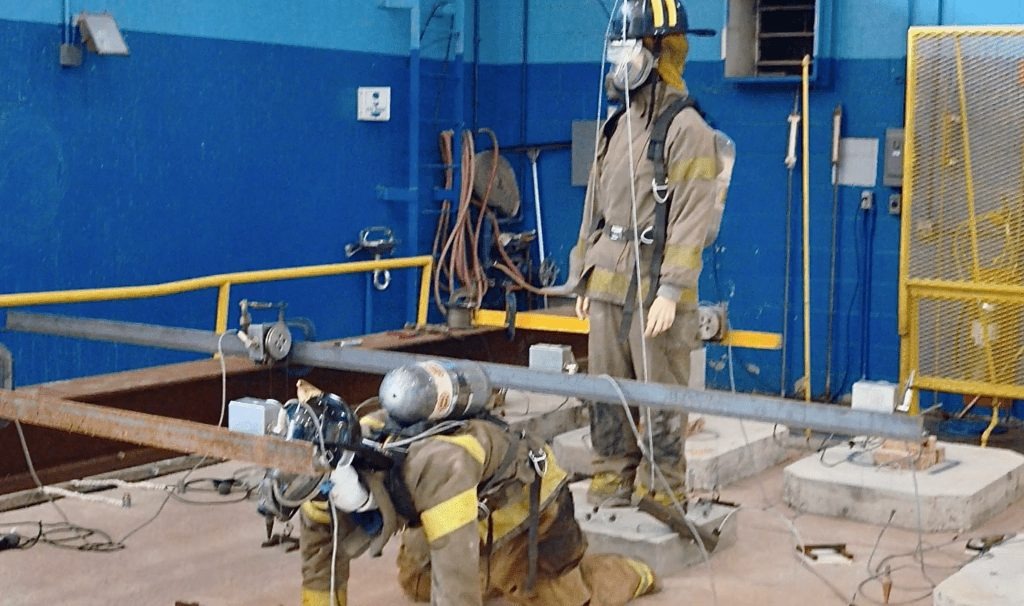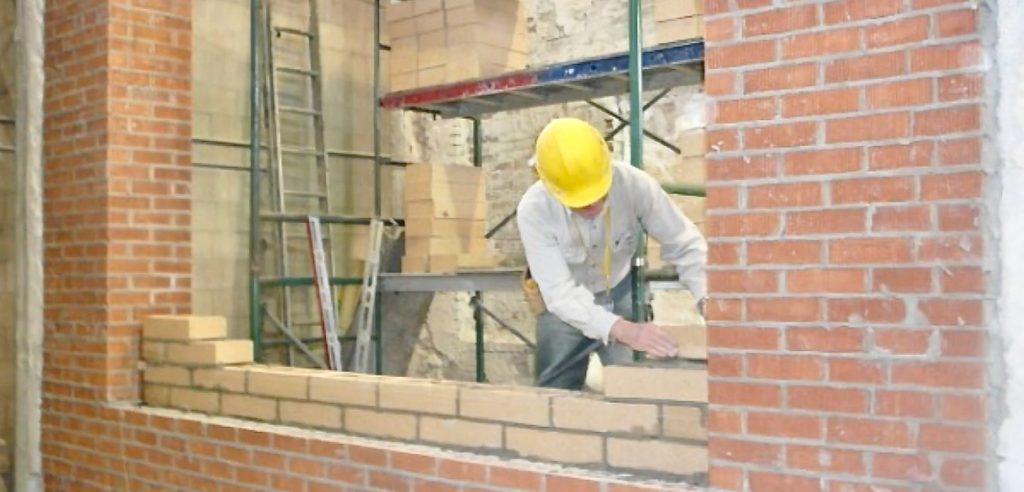Fire Resiliency And Hollow Clay Masonry
Words: Steven Judd
Words and Figures: Steven Judd, Technical Director of Interstate Brick
Photos: Interstate Brick
A much admired, revered, and historically significant cathedral made world news on April 15, 2019, when it caught fire, and the world watched as flames raced up the wooden steeple, eventually engulfing the entire roof structure, but Notre Dame, built in the 12th century, didn’t burn to the ground. The iconic twin bell towers, the nave, the side aisles, the transepts, the chancel, the apse, the ornate arched ceilings, and the famous flying buttresses remained structurally intact and practically undamaged. Why didn’t it burn to the ground? Because all but the roof structure was made of masonry; stone in this case. Masonry doesn’t burn. This was truly a catastrophe, but the principal damage was confined to the wood-framed portion – the roof structure. The cost to replace the roof structure, although significant, is only a very small fraction of what the cost would have been to replace the whole cathedral. This leads us to the discussion of resiliency and masonry durability.
For this article, we will look at resiliency in human terms. Resiliency is the ability to ‘bounce back’ or recover from a stressor, which can be any personal, family, or community (or global) event that causes disruption to the status quo in a negative or detrimental way. Illness or disease can be a personal or community (or global) event that impacts an individual ‘internally.’ Fires, earthquakes, severe storms, floods, landslides, and tidal surges impact individuals (or groups of individuals) ‘externally’ and can be examined in terms of personal stressors, but more likely they involve stressors to larger communities, regions, or even larger geographic areas.
When infrastructure fails – buildings, bridges, dams - normal day-to-day activities are disrupted for some time, and individuals experience stress. Normal life has been impacted. Resiliency - the ability to recover or ‘bounce back’ - is critically impacted by the condition of the infrastructure. If stores and gas stations are destroyed, where does one acquire food and gas? If bridges collapse, how does one get from hither to yon?
There is a way to discuss resiliency in a visual, or graphic way:
From the above event recovery graph, following the solid red line from left to right, we can see that life is going on at a 100% functional level, whatever that is, and then an event happens that decreases the functionality of whatever is being measured. Then things are addressed/managed/repaired/rebuilt until functionality returns to “normal” or where it was prior to the event – the 100% level. The gray triangular shape of the event-recovery graph is called the resiliency triangle. The dashed red line represents a less dramatic event, with a much smaller resiliency triangle. (Maybe a flat tire on your car.) This graph represents the idealized situation.
In reality, the “resiliency tringle” shape is often not triangular. It may have a flat bottom like this:
This shape depicts some “down time” prior to the start of recovery, perhaps waiting for FEMA funding or mobilizing labor or equipment. Keep in mind that the recovery effort is unlikely to be a smooth upward slope, as well. It may have periods of fast recovery, and/or periods of slow recovery, and/or delays for materials or weather, and the end result may never actually be back to the pre-event functionality level. Sometimes the recovery process enhances the functionality to provide better functionality than before the disruptive event, such as an old building collapsing and being replaced with a newer, more up-to-date building. The “resiliency triangle” is most likely a very irregular shape.
One way or another, resiliency, or recovery, relates to the condition of the infrastructure, and in many cases, to buildings or facilities. It is hard to buy groceries or seek medical help if the buildings that provide those services have been destroyed. It is also hard to use one’s cell phone if the buildings protecting transmission equipment have been destroyed. Resiliency can be enhanced by constructing durable buildings and facilities. So, resiliency and structural durability go hand in hand.
Durable structures can be designed and constructed to withstand the effects of various stressor events with programmed amounts of damage if they are built with the correct materials. One can design and build a very durable building to resist design event wind and seismic induced forces out of wood, which may be completely decimated by fire. The choice of construction materials is critical to enhanced resiliency. “Important” facilities like hospitals, fire stations, communication facilities, police stations, and all supporting infrastructure and amenities generally want to be immediately functional or operational after a prescribed damaging event, be it fire, flood, wind storm, earthquake, or another disastrous event. Such facilities need to have good design, high strength and durability, quality construction, and materials that resist effects from as many events as possible, such as reinforced hollow clay masonry.

If a municipality needs a new fire station that is durable and resistant to fire, it probably won’t build it out of wood, which can burn. Many communities have chosen reinforced hollow clay as the appropriate material for those essential facilities because of its beauty and durability. Reinforced hollow clay masonry is non-combustible and is always at a 100% functional level to resist fire. It can’t be turned off and never needs to be turned on. It always stands ready and works as a fire spread deterrent 100% of the time.
The latest statistics from the National Fire Prevention Association and American Fire Sprinklers Association about Automatic Extinguisher Systems (fire sprinklers) state: Sprinklers operated in 92 percent of the fires that were large enough to activate them. Of those fires, sprinklers were effective at controlling 96 percent of the fires.1 So, those figures indicate that automatic fire extinguishing systems may be only effective in suppressing fires an average of 88% of the time. That seems like a low percentage when life safety is involved. The research indicated that sometimes, the active suppression system did not function because it had been turned off. Why would you want to be able to turn off a life safety feature?
Fire-rated reinforced hollow clay masonry walls are 100% effective 100% of the time for the given fire-resistive rating. Fire-rated reinforced hollow clay masonry walls can’t be turned off; they never need to be recharged, and they never need to be turned on. A 4-hour fire-resistive rating, for instance, can be achieved using a wall comprised of 8” thick hollow clay masonry where the open cells are filled with grout, sand, pea gravel, vermiculite, perlite, or many other non-combustible materials. The IBC has tables that provide resistive fire ratings for different equivalent solid wall thicknesses for clay units (and concrete). At least one Hollow Clay Masonry manufacturer has passed UL laboratory testing and received UL 935 certification of a 4-hour fire rating for walls using their 8” thick units.

Reinforced hollow clay masonry used as fire-resistive rated separation walls, exterior walls, and apartment dividing walls are fully functional and active as fire-resisting systems 100% of the time. These walls can be part of the primary load resisting system for gravity and lateral loads as well. Reinforced hollow clay masonry can be used to create durable structures and can resist not only fires, but extreme winds, tsunamis, blast forces, ballistics, earthquakes, and even termites while supporting all of the gravity loads of the building. Reinforced hollow clay masonry doesn’t burn, doesn’t give off smoke and the mass of the walls helps regulate temperature swings in the tempered spaces. Reinforced hollow clay masonry walls can be constructed on zero lot lines, built from the inside of the building without the need for exterior scaffolding, as recently presented in an IMI-sponsored webinar.
Reinforced hollow clay masonry construction is one of the strongest and most durable construction materials available, which can be utilized to construct extremely durable facilities that can resist many aggressive naturally or human-induced events, with little or no damage, which enhances the resiliency of those relying on those facilities in the built environment. Well-designed, well-constructed, durable reinforced hollow clay masonry buildings can significantly enhance resiliency, making things a little more bearable when life becomes difficult.
Notes: 1. Case Study: Sprinkler Systems Save Lives & Protects Property - Brothers Fire & Security (brothersfireandsecurity.com)